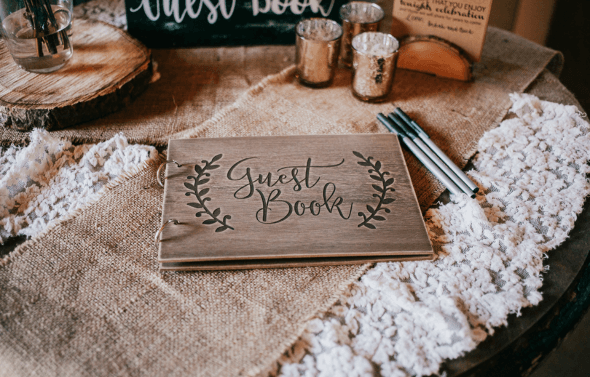Airbnb Welcome Book: How to Wow your Guests?

Key Takeaways
A great welcome book sets the tone for a five-star stay. It’s more than just house rules, it shows thoughtfulness, builds trust and helps guests feel at home from the moment they arrive.
Include everything guests need in one place. Wi-Fi details, check-in instructions, emergency contacts, local recommendations and appliance guides all belong here for a smoother guest experience.
Choose the right format for your audience. Digital books are convenient and easy to update, while handcrafted versions add a personal touch guests love. Many hosts offer both.
Keep it organized and easy to navigate. Use a clear table of contents, tabs or clickable links so guests can quickly find what they need without messaging you.
Add personal touches that make it memorable. A short welcome note, local tips and a guestbook for feedback turn a standard guide into something warm, personal and worth remembering.
A well-crafted Airbnb welcome book isn’t just helpful, it’s a powerful way to make your guests feel informed, cared for and at home. Whether you choose to go digital or handcrafted, your book should be thoughtfully organized, easy to navigate and tailored to your guests' needs. It sets the tone for a five-star experience, encourages positive reviews and can even lead to repeat bookings.
Here’s a quick reference table outlining the key sections to include in your Welcome Book:
Section | Purpose / What to include | Bonus tips |
1. Welcome page | Warm greeting, host’s contact info, property address, Wi-Fi details, emergency numbers | Add a personal story or note. Include a space for guest comments or feedback. |
2. Table of Contents | Helps guests quickly navigate to relevant pages | Use tabs or colored dividers to make access easier. |
3. Check-in & arrival info | Step-by-step instructions for accessing the property, parking info, key codes, smart locks | Add a brief welcome message and highlight essential amenities like coffee machine or AC. |
4. Emergency info | Fire/police/hospital contacts, fire extinguisher & first aid locations, quiet hours | Emphasize safety and preparedness to build trust. |
5. House rules | Clearly state your rules: pets, smoking, quiet hours, etc. | Keep tone friendly and rules reasonable. |
6. Local attractions | Must-see sites: museums, landmarks, theme parks | Add photos and consider partnering with local attractions for guest discounts. |
7. Places to eat | Restaurant recommendations with contact info, cuisine types, travel time, delivery options | Include menus or pamphlets. Highlight local favorites and offer variety. |
8. Getting around | Public transport info, taxi/rideshare services, car/bike rentals, local maps | Highlight your property’s location on the map and allow guests to take a printed copy. |
9. Appliance instructions | How to use Wi-Fi, thermostat, kitchen appliances, smart devices, washer/dryer, entertainment systems | Include clear steps and diagrams if possible—especially helpful for older guests. |
10. Frequently Asked Questions (FAQ) | Recap of common questions about check-in/out, appliances, rules, local tips | Keep answers short and clear. This section works well as a quick reference. |

Introduction to Airbnb Welcome Books
An Airbnb welcome book is more than just a collection of house rules and instructions, it’s your opportunity to make guests feel truly welcome and at ease from the moment they arrive. By providing a thoughtfully curated guide, hosts can share local tips, highlight the best features of the property and introduce guests to the unique charm of the local area.
A well-prepared welcome book not only helps guests navigate their stay with confidence but also sets the stage for positive reviews and repeat bookings. Whether you’re new to hosting or a seasoned Airbnb pro, investing time in your welcome book can transform your property into a memorable destination, making guests feel valued and appreciated throughout their visit.

Hand-Crafted Vs. Digital Airbnb Welcome Book: What Kind of Welcome Book Should You Create?
Before you start building your Airbnb welcome book, think about which format will work best for you and your guests: digital or handcrafted. Both have their own advantages and the right choice often depends on your guest profile and your personal hosting style.
Digital welcome book
A digital welcome book is a modern, convenient option that many hosts prefer especially for its flexibility and ease of use. With a digital version, you can:
Organize essential information in a clean, accessible format
Include interactive elements like videos, photos and clickable maps
Send it to guests before they arrive, helping them get excited about the stay and plan their holiday in advance
Schedule it to be sent automatically, saving you time and creating a seamless guest experience
Update it anytime without needing to reprint anything
That said, there are a few things to consider. Potential limitations include:
Some guests may not be tech-savvy
Older guests may prefer printed materials
Limited internet or Wi-Fi access could make a digital-only guide less practical
Handcrafted welcome book
A printed or hand-assembled welcome book offers a more personal, tactile experience. It’s perfect for guests who enjoy flipping through pages and discovering little touches, like handwritten notes, local brochures or even a map they can take with them.
It may take more effort to put together, but your guests will notice the care you’ve put into it and that can go a long way in making their stay memorable.

Key Components in Creating an Airbnb Welcome Book
When planning your Airbnb welcome book, it’s important to make it clear, concise and thoughtfully organized. You can either create it from scratch, customizing the design, layout and tone to match your property, or use downloadable templates to save time and ensure a professional finish.
Digital templates are convenient, you can also add personal touches that guests will appreciate. From welcome and instructional videos to tailored recommendations, even small customizations can go a long way in making guests feel welcome.
If you're not sure where to start, don’t worry, we’ve broken it down for you. Below is a step-by-step guide to the essential sections every great Airbnb welcome book should include.
1. Welcome page
Your welcome book should begin with a warm, inviting welcome page. This sets the tone for your guest’s entire stay. Start with a short, personalized message thanking them for choosing your property and letting them know you're excited to host them.
Include these essentials right up front:
Guests may not read the entire book, so make sure the most important details are easy to find within the first pages:
Your full contact information
The rental property address
Parking instructions (if applicable)
Wi-Fi network name and password
Emergency contact numbers (police, fire, medical)
These basics save your guests from having to reach out unnecessarily and show that you’ve thought of everything in advance.
Host introduction
Right after your welcome note, include a short section introducing yourself. This isn't just a nice touch, it helps build trust and adds a human connection to your space. Guests enjoy knowing a bit about who’s hosting them and what inspired you to open your property to travelers.
Make sure to include:
A friendly photo of yourself (or your hosting team/family)
A few sentences about who you are, your connection to the property and why you love hosting
This simple inclusion creates a sense of authenticity and comfort from the very beginning.
2. Table of contents
A clear, well-organized table of contents is one of the most helpful parts of your welcome book. It allows guests to quickly find the information they’re looking for without having to flip through every page.
Whether they want to check Wi-Fi details, find local restaurants or go through check-out procedures, guests can simply scan the contents and jump straight to the section they need.
To make navigation easier:
Depending on your format (digital or printed), here are a few ways to enhance usability:
Clickable links in digital welcome books make it easy for guests to jump directly to specific sections or external resources.
Tabs or dividers in physical books allow guests to flip quickly to key areas like house rules or local attractions.
Remember, a well-structured table of contents not only saves guests time it makes your welcome book feel professional and thoughtfully designed.

3. Check-in and arrival information
The check-in and arrival information section of your welcome book is essential for ensuring a smooth start to your guests’ stay. Begin by providing clear instructions on how guests can access the property, such as door codes, key locations or smart lock procedures.
Include detailed parking information so guests know exactly where to leave their car upon arrival. Make sure to specify your check-in and check-out times and outline any important steps or requirements for both arrival and departure.
A personalized welcome message can go a long way in making guests feel at home. Consider adding a brief note to greet them and explain how to use key amenities like the thermostat or the coffee machine. By offering straightforward, easy-to-follow guidance, you help guests settle in quickly and start enjoying their stay right away.
4. Emergency information
Safety and peace of mind are top priorities for any guest, so your welcome book should include a dedicated emergency information section. List important contact details, such as the phone numbers for the fire department, nearest hospital and local police.
Clearly indicate the locations of fire extinguishers, emergency exits and first aid kits within the property. It’s also helpful to outline any relevant regulations, such as quiet hours or noise restrictions, to ensure a respectful and secure environment for everyone.
Note: While some of this information may already appear on the welcome page, this section is designed to bring all essential safety details together in one easy-to-find place.
.png?u=https%3A%2F%2Fimages.ctfassets.net%2Fpqmtoyw9z10u%2F4p5WkocZ9gfSZTu2MpWyT5%2Fa4b701c8a82bfafe2954bfc4594ea658%2FHouse_Rules__1_.png&a=w%3D590%26h%3D377%26fm%3Dpng%26q%3D75&cd=2025-08-28T19%3A15%3A04.102Z)
5. House rules
Clear, friendly house rules help set expectations and ensure a smooth, respectful stay for everyone. Keep your tone welcoming, but be direct about what’s important guests appreciate knowing what’s expected of them upfront.
Common house rules to include:
Check-in / check-out times – and any related procedures
No smoking (or specify designated smoking areas if allowed)
Pet policy – whether pets are allowed and any related guidelines
Quiet hours – especially if your property is in a shared building or residential area
Visitors/parties – clarify whether outside guests are allowed
Clean-up expectations such as where to put used towels or how to handle trash
Tips for writing great house rules:
Keep rules simple and easy to understand
Avoid sounding overly strict, a friendly tone is more effective
If there are consequences for breaking key rules (e.g., fines, security deposit impacts),mention them clearly
6. Must-see local attractions
Mention the must-see attractions around the area such as:
Museums and Art galleries
Historical places
Local attractions
Theme parks
Recommendations will always be appreciated by guests. Additionally, consider including a picture of the local attractions to help guests visualize the experiences they can enjoy. This will entice guests with an opportunity to have a once-in-a-lifetime experience during their stay.
Bonus Tip: Approach and partner with other businesses that can provide guests with offers such as discount vouchers, etc.

7. Places to eat
Ideally, after a long drive or flight, most guests look for the closest places to eat. It would be great to recommend places or maybe share your top pick restaurants to eat around the area with a variety of food as well as different types of restaurants from casual to fine dining.
Make sure you include addresses, contact numbers and the website of the restaurants you suggested. You could also provide information on the proximity or how long it takes to get to the restaurants.
Consider also suggesting restaurants with delivery options for guests who might just want to stay in.
Bonus tip: Add menu pamphlets and discount coupons to the welcome book from restaurants you've partnered with.
8. Getting around
Include a section in your welcome book with helpful information on local transportation options, such as:
Recommended Taxi services with contact information
Uber Services
Car rentals in the area
Nearby bicycle rentals
Airport or City Tour bus Shuttles
Public transportation options and schedules

9. How-to instructions on appliances and electronics
Don’t assume guests are familiar with how your appliances or electronics work. Be sure to include clear, easy-to-follow instructions for all key appliances and electronics in your home.
What to cover:
Thermostat
Water Heater
Kitchen appliances
Smart home devices (locks, lights, etc)
TV Remote Control, DVD Player and Netflix
Wifi password
Washer and dryer
Providing this guidance shows you’ve thought of everything, it can go a long way in ensuring smooth stays and positive reviews.
10. Frequently Asked Questions (FAQ)
On this page, you are likely to provide answers to any commonly asked questions like:
Check-in and check-out time
Check-out procedures
Location of switches
The proximity of restaurants, hospitals, grocery stores, bank/money exchanger counters, etc
Security
House rules

Guest Book: Inviting Feedback and Memories
A guest book is a wonderful addition to your Airbnb listing, offering a space for guests to share their experiences, feedback and favorite moments from their stay. By inviting guests to leave messages, stories or even pictures, you create a sense of community and connection that enriches both your hosting journey and future guests’ experiences.
This can be as simple as a notebook on the coffee table or as creative as a scrapbook filled with quotes, photos and personal touches. Not only does this provide valuable insights for you as a host, but it also gives guests a chance to contribute to the ongoing story of your property. Over time, your guest book becomes a cherished keepsake, filled with memories and inspiration for everyone who visits.
Digital Guidebook Examples and Templates
If you’re looking to create an effective Airbnb welcome book but aren’t sure where to start, there are plenty of examples and templates available to guide you. Digital welcome books, like those offered by Touch Stay and RueBaRue, make it easy to keep information up to date and accessible for guests on their devices.
These digital guidebooks can showcase your property and local area with interactive maps, photos and links to local businesses and must-see attractions. For those who prefer a printed version, downloadable templates provide a professional layout that you can customize with your own personal touches and local tips.
By using these resources, you can save time while ensuring your welcome book is comprehensive, visually appealing and tailored to your guests’ needs, helping you deliver an enjoyable stay and a positive guest experience every time.

Final Touches That Leave a Lasting Impression
Airbnb welcome book offers guests a lot more than you expect. it helps guests navigate their stay with great experiences and guides. It adds value to your property by being a great host and in the long run guests not only leave great reviews back but recommend your property to other guest
Just a small pointer in organizing your Airbnb welcome book. Have a printed copy of the welcome book for guests who prefer a physical copy. Make markers to highlight pages for guests to easily navigate. As it comes in different formats, use a binder or scrapbook to keep all the pamphlets, menu cards, vouchers, etc. organized. And lastly, leave it in a visible location for guests to see, such as on the living room coffee table or the dining table.
Frequently Asked Questions
1. Do I really need an Airbnb welcome book?
Yes. A welcome book is more than just a nice extra—it makes your guests feel cared for, reduces repetitive questions and sets the tone for a five-star experience. It also helps improve reviews and repeat bookings.
2. Should I choose a digital or a printed welcome book?
It depends on your guest profile. A digital welcome book is easy to update, can be sent ahead of time to build excitement and works great for tech-savvy travelers. A handcrafted book, on the other hand, adds a personal, tactile touch that many guests appreciate—especially those who prefer something physical.
3. What’s the most important information to include?
Always start with the essentials: Wi-Fi details, emergency contacts, check-in/check-out procedures and your contact information. From there, add local recommendations, house rules and appliance instructions.
4. How long should my welcome book be?
Keep it concise but complete. The goal is to be helpful, not overwhelming. Use a table of contents, clear headings and (if digital) clickable links so guests can easily find what they need.
5. Where should I place the welcome book in my property?
For physical books, choose a visible, central spot such as the coffee table, kitchen counter or dining table. Digital versions can be pinned in your Airbnb messages and shared via email or a link.
6. Do I need to update my welcome book regularly?
Yes. Keep details like Wi-Fi, emergency contacts and appliance instructions accurate and refresh restaurant or local attraction recommendations as things change. Outdated information can cause frustration.